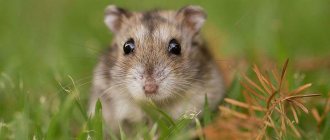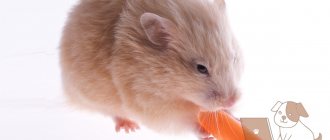Breeding Djungarian hamsters is a fairly simple and interesting business. If you have bought an opposite-sex couple and want them to have offspring, you need to know a few basic things that will help you protect the expectant mother and babies, as well as make the breeding process fun.
How to care for dzhungarikas during pregnancy?
Offspring may appear unexpectedly if you bought a pregnant female or a boy and a girl instead of a same-sex pair. In this case, it will also be useful for you to learn how to care for dzhungarikas during this difficult period for them.
Pregnancy and childbirth among Djungarians
If you decide to consciously approach the issue of breeding hamsters, then males and females should be kept separately and placed together only for mating when the female goes into heat.
IMPORTANT! In nature, hamsters are territorial animals and will fight with each other in any conditions. There are cases when hamsters live peacefully, but this is only a rare exception to the rule. So if you don't want your furry friends to hurt each other, invest in an extra cage.
In addition, separate housing will allow you to more or less accurately determine the date of birth.
How can you tell if your hamster is pregnant?
If you missed the moment of mating, it is quite difficult to determine pregnancy in a dzhungarik. At first, the female may become more nervous and restless. Towards the end of pregnancy, her belly becomes noticeably enlarged. If the hamster begins to noticeably become rounder, this is a sure sign that birth is near.
How long does pregnancy last for a hamster?
Djungarian hamsters bear offspring from 17 to 21 days. If labor does not begin on days 22-23, this is a reason to consult a doctor.
Number of cubs
Typically the offspring size ranges from 2 to 9 babies, with an average of 4-6. It also happens that the heroine mother gives birth to up to 18 cubs. The female eats weak and sick babies on the first day. This is normal and not worth fighting against.
Hamsters need a large cage to breed.
What does a pregnant hamster look like?
During pregnancy, the female's belly increases. A pregnant jungarik strongly resembles a pear. Determining pregnancy in a Syrian hamster is more difficult, especially in long-haired individuals. The size of the belly depends on the period and number of fruits.
The nipples also enlarge and are visible from under the fur, because the female has to feed the cubs. In addition to external signs, there are indirect ones - the behavior of the animal.
How does a pregnant hamster behave?
- curls up into a ball;
- shows increased aggressiveness;
- walks carefully and slowly;
- looks for secluded corners, arranges a nest;
- increased appetite and thirst.
Caring for a pregnant dwarf
Hamsters need a fairly large cage to breed. An area of 30 x 50 cm is the minimum, because jungarians run around a lot and love space.
The room temperature should be maintained between 21-25 degrees. Place the cage in the shade so that it is not exposed to direct sunlight. Lack of physical activity can easily lead to obesity, so it is advisable to equip the cage with a running wheel.
What to feed?
IMPORTANT! Proper nutrition is the main condition for the birth of healthy offspring. The better the expectant mother eats, the less likely she is to give birth to weak or dead babies.
The basis of the diet should be a complete mixture, which can be purchased at a pet store. In addition to the food, provide plenty of fruits and vegetables.
During pregnancy, your diet should contain more protein than usual. To do this, give low-fat cottage cheese, egg whites, small pieces of boiled chicken (in small quantities) or baby meat food every day. You can also offer dried gammarus larvae.
ATTENTION! You should not give Djungarian hamsters bread or crackers. They contain yeast and can lead to increased gas formation and disruption of the gastrointestinal tract.
Buy special mineral-calcium supplements. They are necessary for the correct formation of the skeleton in the offspring. If there are not enough minerals in the female’s diet, then the material for building the bone structure of the babies will leave her own body. A weakened hamster will not be able to give birth normally and feed its offspring.
Providing conditions for a pregnant hamster
With the onset of pregnancy, the female must be provided with maximum rest. Don't pick her up. If she begins to react aggressively to the male, then he should be placed in a separate cage.
Did your hamster react aggressively towards the male?
The hamster must have enough material to build a nest. In addition to the usual cage litter, you can also offer soft toilet paper and some hay. It is important that the material is soft, does not contain dyes and does not damage the delicate skin of newborns. Under no circumstances should newspapers be placed in the cage; printing ink contains harmful substances!
The wheel should be removed during pregnancy
What to feed a pregnant hamster
Pregnant hamsters are strikingly different in their needs from ordinary adult animals. The fetuses develop in record time, exhausting the mother's body. Therefore, food should be high in calories, easily digestible, and not negatively affect the process of bearing babies.
Juicy feed
In addition to the strict exclusion of prohibited foods, most fruits and vegetables allowed at normal times are stopped.
You can't feed apples and pears.
Allowed are carrots, zucchini and pumpkin. They are given daily, in 1 cm pieces. Sometimes you can diversify the diet with dried herbs and dill. Seed sprouts (oats, wheat) are very useful. You need to feed your pregnant hamster vegetables and salads that are as chemical-free as possible, if not from your own garden, then at least seasonal ones. They are peeled and soaked if necessary.
Protein feed
For normal development of the cubs, a pregnant hamster must receive food rich in protein and calcium at least 2 times a week (2-3 times). It could be:
- boiled dietary meat without salt and spices (chicken, beef, rabbit);
- good quality baby meat puree (turkey, beef);
- boiled egg (quail or chicken);
- low-fat cottage cheese, yogurt (up to 1%).
Dry food
The grain mixture remains the main source of energy when the animals bear offspring. Dry food should be of good quality, and it can be given as much as possible - a pregnant Djungarian or Syrian eats much more than usual.
7-10 days after mating, a double portion of the grain mixture is poured.
A good addition to the food would be grass rings with alfalfa. 8 in 1 - Multi-VitaminDailyCruncyTreat or Vitakraft - GrignoteRolls treats are a safe source of calcium and vitamins. You can give them every day, and if your pet doesn’t like the rings, then she will eat them soaked in warm water without leaving a trace.
Water
A female hamster may drink a lot during this period, this is not a cause for concern. It is necessary to change the water in the drinking bowl daily and ensure that there is enough water. You can add liquid vitamins for rodents to the water.
How can you tell if a female is about to give birth?
As birth approaches, the female becomes more passive. Her tummy is noticeably rounded, because the most intense growth in babies occurs in the last days of pregnancy. The expectant mother begins to build a nest.
At this time, the running wheel is removed from the cage. If desired, you can place a floor house for a future nest.
In the last 3 days before giving birth, the female's thirst increases, so carefully monitor the presence of water in the drinking bowl.
2-3 days before the birth, it is necessary to wash and disinfect the cage so that after the birth you do not bother the babies with cleaning and do not irritate the young mother. Your own, well-known smell is a guarantee of peace and confidence in your safety for any animal.
How do hamsters give birth?
We improve living conditions
If the animal’s cage is not equipped with an additional internal house or other “shelter” where the female can place her babies, you should take care of this immediately after the news of the upcoming replenishment.
You don't have to buy a house. The construction of the nest can be left to the hamster directly. She will happily arrange the “nursery” on her own. It is important to help her with building materials. All kinds of shreds and napkins (without aromatic additives) are perfect for this role. The basis of the house can be a cardboard box of the appropriate size.
After the female has completed construction, touching the hamsters’ home is strictly prohibited. This ban lasts until the newborn reaches 2 weeks of age.
How does childbirth go in Djungarians?
Typically, births occur at night, and the owners find the newborn offspring in the morning. The hamster, as a rule, copes on her own. But in rare cases, especially during the first birth, she may need the help of a doctor:
- the female has noticeable contractions, but cannot give birth within 15 minutes;
- within 30 minutes after the birth of the first baby, no others appear.
A healthy mother will definitely eat after giving birth before starting feeding. If she refuses to eat, this is also a symptom of complications.
Hamsters are born covered with a shell, which the female chews, and the baby can take its first breath. Immediately after birth, little hamsters are completely helpless - they cannot see or hear. But at the same time, they can already sense smells perfectly.
THIS IS INTERESTING! Hamsters are born with teeth, and their incisors grow throughout their lives. Teeth need to be ground down, which is why it is so important to give hamsters solid food.
However, it also happens that cubs are born dead. The reasons may be different:
- too young female;
- poor nutrition;
- water scarcity;
- lack of vitamins and minerals in the diet.
A day after giving birth, the female is ready for mating
Possible abnormalities in hamster pregnancy
Usually there are no deviations during pregnancy. Domestic hamsters, both Syrian and Djungarian, easily bear babies. But there are situations when you cannot do without the help of a veterinarian:
- If the animal cannot give birth on its own for a long period of time.
- If the female eats the babies after giving birth.
- If a pregnant hamster behaves strangely, it makes sounds that are unusual for it.
A veterinary clinic specialist can perform an ultrasound examination to determine the condition of the pregnant hamster and its cubs. But you should know that such a trip is very stressful for a hamster, so you should resort to it only when absolutely necessary.
Where to keep the male: together with the babies or separately
If you have not done this before, the male should be removed before giving birth or immediately after the offspring appear. There is a high probability that his instincts will take over and he will eat all the cubs.
In addition, within a day the female is ready to mate again. Repeated pregnancy at this time is extremely undesirable, because it will lead to exhaustion of the hamster and can cause the death of both the mother and the newborn offspring.
You should not interfere in the lives of newborns
Puberty
Djungarian hamsters reach maturity at 1-2 months. At this age, rodents are already able to mate, but the female is not physically ready for pregnancy. The first acquaintance with a male should be postponed until her body is fully formed.
The first mating can be organized when the hamster is 4-5 months old. At this age, the dzhungarik is already ready to take care of the offspring, and pregnancy and childbirth will proceed without complications. Males can mate from the age of three months.
Caring for Djungarian hamsters after birth
The less you interfere in the life of a young mother and her offspring, the better. An overly anxious mother, especially after the first birth, can constantly drag her babies around the cage in search of the safest place. Newborn babies can die in this case, so it is necessary to provide the family with maximum peace.
Place sheets of white toilet paper in the cage so that the female can cover her babies when she is away.
If the birth of your babies came as a complete surprise to you, and you did not prepare for this event, then it is still advisable to wash the cage. To do this, the babies are taken out of the cage along with the nest. It's best to do this with a tablespoon or a ladle because they won't affect the smell. It is better to wash the cage with baby or laundry soap. Leave some of the old filler in order to maintain the usual smell around the nest.
What to feed a newborn hamster?
The diet of a nursing mother is approximately the same as during pregnancy. But it is very important that she always has access to fresh drinking water and protein foods. Don’t forget about mineral supplements - calcium also goes with milk.
Hamsters are born blind
Features of different breeds
The gestation period for different breeds of hamsters varies slightly, so you should study their characteristics in advance.
Syrian
Representatives of the Syrian breed develop aggression towards the male during pregnancy. The female will try to bite him and even kill him, so after mating the animals must be seated in different cages.
Djungarians and other dwarf hamsters
In Djungarians, aggressiveness does not arise so clearly, but experts still advise separating future parents.
Representatives of the Campbell breed can stay with the female and even help in raising the offspring.
How to keep a couple before mating: together or in different cages
Hamsters of this species reproduce well, and in captivity they are able to do this throughout the year. However, for this process they need to create certain conditions. So, before mating, it is better to keep the female and male in different cages, since they can show aggression towards each other - they will fight for territory. They need to be combined in one cage only for the duration of mating.
Note that peaceful coexistence of a boy and a girl in the same room is possible, but this is quite rare. If you do not have the opportunity to buy another cage, then you can place the female with the male for a while. Who knows, what if your couple will be on the list of those rare ones who live in peace and harmony. If the experiment fails, then it will still be necessary to decide to purchase a new cell. It is unlikely that you will like to put up with scratches and scraps of torn fur.
Read on for tips on choosing a cage and ball for your hamster.
You can avoid conflicts if you buy a girl and a boy at the same time and at the same time place them in a new cage. In this case, one male can even get along with several females. You should avoid placing a younger female with a male who has already been living with you for some time. In this case, war cannot be avoided.
Did you know? Experienced breeders have noticed that in a territorial war between males and females, the latter almost always win, and the males are inferior to them.
Deviations and contacting a veterinarian
There cannot be any deviations in the greater direction: if pregnancy in hamsters drags on for more than a couple of days, this is a pathology, or the female was not pregnant at all. It happens that a hamster gave birth at night and ate the babies. Then the unlucky breeder expects birth, but there is still no birth.
Due to the fact that the gestation period of Djungarian hamsters is short, and that of Syrians is even shorter, owners would never even think of taking the rodent to a veterinary clinic for an ultrasound. Theoretically, a good specialist will determine the very fact of pregnancy, but it will be impossible to say the duration or number of fetuses.
For an animal, visiting a clinic is extremely stressful and must be avoided at all costs.
It is permissible to consult a doctor for ultrasound diagnostics only if the owner suspects the presence of health problems (an enlarged abdomen can cause ascites, pyometra) or a pregnancy pathology (frozen fetuses). To understand whether a hamster is pregnant, it is enough to observe it at home for a couple of weeks.
Caring for the safety of babies
To prevent your pet from eating the babies, try to clean the cage in advance of the birth. After the babies are born, access to the hamster’s home should be limited as much as possible. Do not pick him up for communication, do not try to touch or stroke the offspring. All that is required of the owner is to carefully clean the toilet area and put food in the cage. Place the hamster's house in a quiet and calm place, eliminating the occurrence of anxiety. Several rules will help protect the cubs from the aggressive behavior of the female:
- try to minimize stressful situations;
- do not add other hamsters to the cage;
- provide the rodent with adequate nutrition;
- allow females to give birth between 4 and 12 months of age;
By providing the pet with favorable conditions during gestation and the feeding period, the likelihood of eating its own young can be reduced to zero.
When can you take hamsters away from their mother?
Hamsters are born absolutely helpless: they are blind, deaf, completely hairless and red; for minimal orientation in space and finding the mother, the babies have a slightly developed sense of smell. In general, they are completely dependent on their mother and are very vulnerable - little hamsters will not survive without their mother until they are 10 days old!
Some development features:
- on the 5th day the first fur appears;
- at the age of a week, babies begin to try solid food;
- on the 14th day the eyes begin to open;
- On days 20–21, lactation ends completely and the babies switch to independent feeding.
Did you know? At birth, the weight of a baby hamster does not exceed 2 g, and its size is only 10
–
15 mm!
Around this time, they can be taken from their mother and placed in separate cages. The maximum period until which animals can be kept together is 5 weeks. Keeping pets together for longer is very dangerous, since by nature they are loners and are very jealous of their territory.
Thus, the appearance of offspring in hamsters is a rather exciting, but extremely responsible process. You should not allow pets to reproduce at random, because pregnancy and childbirth are a difficult task for females. Therefore, the birth of small hamsters must be approached responsibly, the intervals between pregnancies must be observed, the female must be given the opportunity to fully recover and the most appropriately provided comfortable conditions for the pet so that the life of her and the babies is safe!
Determination of gender
To avoid getting into the situation described above, you need to be able to distinguish the sex of a hamster. Someone will laugh, saying, what’s so complicated about this? In reality, everything is not so simple. Especially in very small (up to 4 weeks) rodents.
How to determine gender? To do this, the following manipulation is performed. The hamster is placed on the palm of your hand, tummy up. Holding it under the front legs so that the animal does not fall, use your free hand to hold the back of the body and look at the location of the genitals.
If the anus and genitals are far from each other, we have a hamster. If these organs are at a very close distance, we see his girlfriend in front of us.
By the way, the guy’s fur, which covers the primary sexual characteristics, is longer than that of the female representatives.
Birth of babies
The main signs of an approaching birth of a hamster (step by step):
- the birth canal opens;
- the pelvic bones diverge;
- The vaginal membrane disappears.
When there are several hours left before giving birth, the hamster practically does not move and eats almost nothing. The birth itself takes place quite quickly - 3-5 minutes for the birth of each hamster. It is difficult to control the process - hamsters usually give birth at night.
During birth, the hamster is in a sitting position. After contractions, she speeds up the birth of the baby by pulling it out with her teeth. She then rips open the placenta, chews the umbilical cord, and licks the tiny newborn. After the birth process is complete (the birth of all the babies in the litter), the female eats part of the remaining placenta.
If during the birth process the pet is confused or hesitates, it is the owner’s responsibility to help her. You need to carefully grab the hamster with a soft napkin (under no circumstances should you touch the baby with your hand), then with light movements (as if massaging), the tiny body should be cleaned of mucus and released from the fetal membrane. The umbilical cord is cut with sterile scissors. After these steps, you need to put the baby under the mother’s belly and make sure that she accepts (licks) him.











